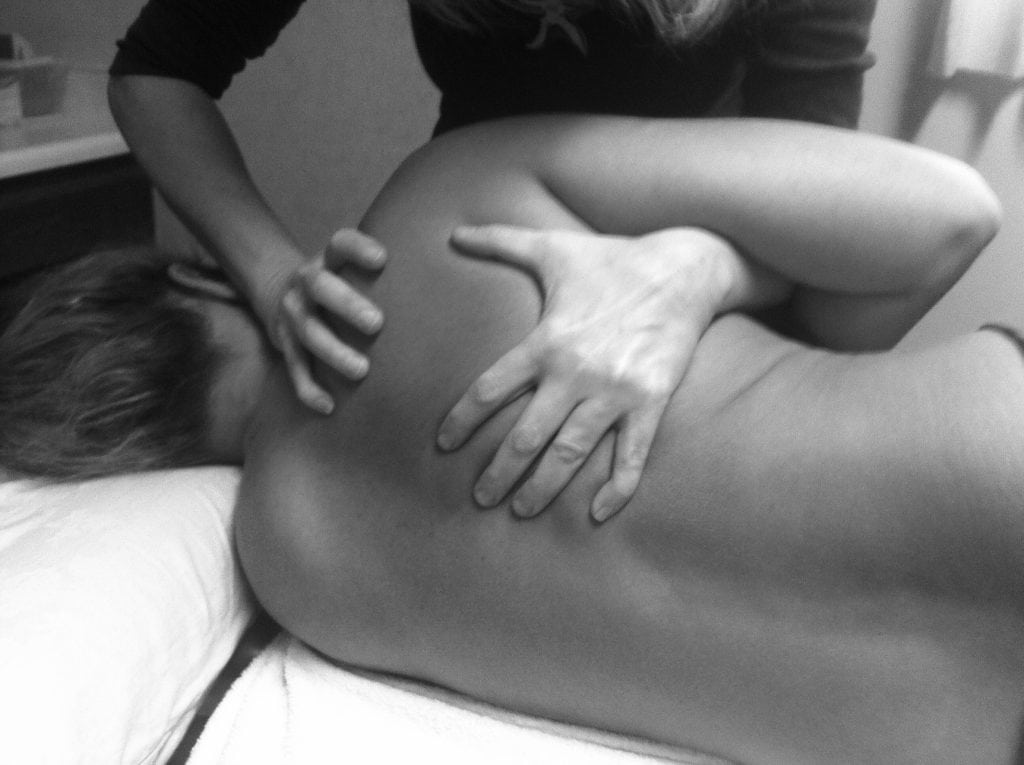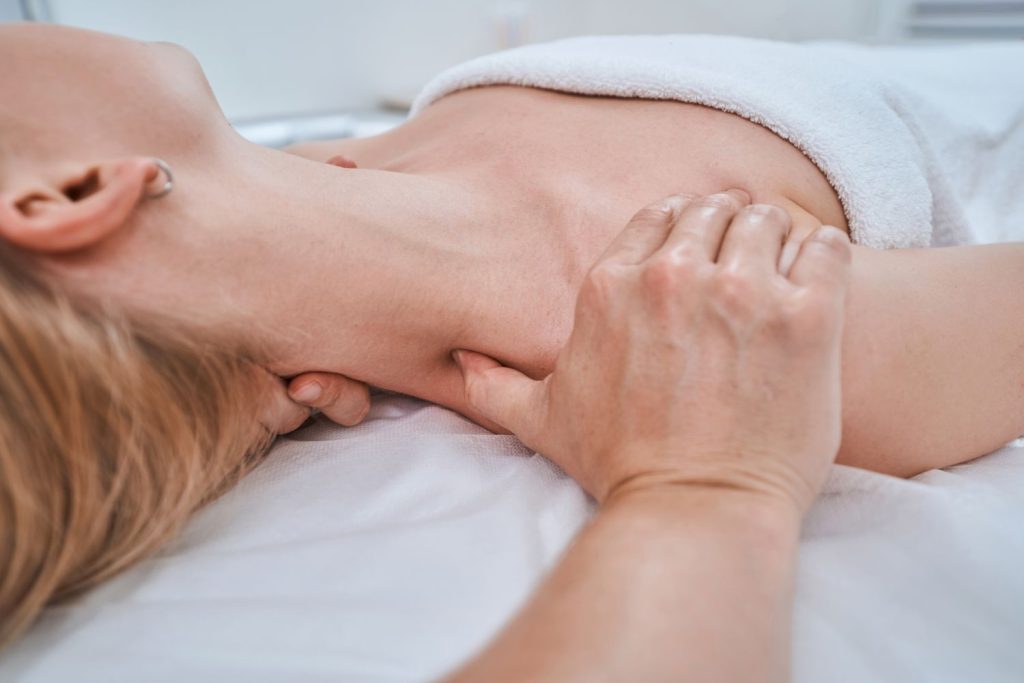What is Manual therapy?
 Manual Therapy is a specialty within the field of physical therapy. Essentially, it is the hands-on component of care and encompasses a broad group of advanced clinical techniques performed by distinctively trained Doctors of Physical Therapy. The treatment approach may include mobilization/manipulation of soft tissue, nerves and skeletal joints. Manual Therapy’s main objective is to foster overall wellness by reducing discomfort, improving function, and it will often yield a dramatic improvement in range of motion and mobility. Furthermore, these treatments can allow active exercise, stretching, and core strengthening to be much more effectively and without discomfort. Incorporating manual therapy with other traditional aspects of physical therapy, such as strengthening and balance, is a powerful and successful combination.
Manual Therapy is a specialty within the field of physical therapy. Essentially, it is the hands-on component of care and encompasses a broad group of advanced clinical techniques performed by distinctively trained Doctors of Physical Therapy. The treatment approach may include mobilization/manipulation of soft tissue, nerves and skeletal joints. Manual Therapy’s main objective is to foster overall wellness by reducing discomfort, improving function, and it will often yield a dramatic improvement in range of motion and mobility. Furthermore, these treatments can allow active exercise, stretching, and core strengthening to be much more effectively and without discomfort. Incorporating manual therapy with other traditional aspects of physical therapy, such as strengthening and balance, is a powerful and successful combination.
 It is important to know there exists different levels of training in manual therapy. The American Academy of Orthopedic Manual Physical Therapists (AAOMPT) is recognized as the premier level of manual therapy achievement. Less than 10% of all physical therapists pursue Fellowship training within their area of specialty. It is an intensive 2–3-year program following doctoral work as a physical therapist. Dr. Sandra Do completed her Fellowship through Regis University in 2007. She is passionate about this field and has continued to pursue advanced training and education. Many of our patients come from across the state to our office, after seeing a multitude of other doctors and therapists, with limited success. You will be amazed at the progress that can be made in a just a few sessions when you are paired with a highly skilled and compassionate practitioner.
It is important to know there exists different levels of training in manual therapy. The American Academy of Orthopedic Manual Physical Therapists (AAOMPT) is recognized as the premier level of manual therapy achievement. Less than 10% of all physical therapists pursue Fellowship training within their area of specialty. It is an intensive 2–3-year program following doctoral work as a physical therapist. Dr. Sandra Do completed her Fellowship through Regis University in 2007. She is passionate about this field and has continued to pursue advanced training and education. Many of our patients come from across the state to our office, after seeing a multitude of other doctors and therapists, with limited success. You will be amazed at the progress that can be made in a just a few sessions when you are paired with a highly skilled and compassionate practitioner.
An effective treatment plan & outcome is dependent on:
- Establishing a trusting rapport through active listening and compassion
- A comprehensive examination of the area(s) involved
- Expert evidence-based plan of care designed to accelerate your recovery
- Treatment that is focused on your impairments and limitations
- Empowering you with self-treatment tools and skills to help manage your recovery independently
The expert manipulation of joints, muscles, soft tissues and other body parts is a common component of manual therapy.
manual therapy may include:
- Myofascial Release: Gentle sustained pressure with elongation of soft tissue/scars/adhesions that can create a profound improvement in your body. Myofascial Release addresses the underlying problems leading to soreness, stiffness, aches, and pains. It restores the proper movement, alignment, and space your body needs in order to avoid pinched nerves, herniated discs, and further breakdown –
- Joint Mobilization: Gentle movements of a peripheral or spinal joint performed by the therapist to improve joint mobility, correct alignment, reduce pain, and restore proper function.
- Joint Manipulation: Also known as spinal adjustments. This involves applying a controlled force to a joint to restore its normal range of motion. Joint manipulation is also commonly utilized by Osteopaths and Chiropractors.
- Soft tissue mobilization: Techniques used to address tension, knots and adhesions in muscles and connective tissues.
- Dry needling: (link to the dry needling page here) a form of therapy in which fine filament needles are inserted into myofascial trigger points (painful knots in muscles), tendons, ligaments, or near nerves in order to stimulate a healing response
- Neural tension mobilization: Assisted gliding of nerves that may become adhered or entrapped due to inflammation, scar tissue or injury.
- Assisted stretching: The therapist may use hands on to support and expand your ability to stretch and achieve muscle length.
- Cupping: The use of glass or plastic cups that allow for suction on the surface of the tight muscle/scar to encourage blood flow and soft tissue mobility. Additional connective tissue stretching may be applied during the cupping procedure.
- CranioSacral Therapy (CST) is a gentle, hands-on method of evaluating and enhancing the functioning of the craniosacral system – comprised of the membranes and cerebrospinal fluid that surround and protect the brain and spinal cord. Using a soft touch your therapist will release restrictions in the craniosacral system, which has been shown to improve the functioning of the central nervous system, aid with headaches, neck pain as well as other systems of the body
- Visceral manipulation: is a gentle, hands-on manual therapy used to help your internal organs (viscera) glide smoothly within your body. Your physical therapist can use this technique to treat abdominal pain, constipation, cramps, indigestion, and much more. Your internal organs are surrounded by connective tissue that holds them in place in the body. Healthy connective tissue should move easily to allow organs to slide on each other when you rotate or flex your torso.
- Manual traction: A technique used to improve neck and low back mobility, range of motion, and overall function. Traction is used to help separate the discs, joints, and bones in your spine. The therapist will perform spinal decompression which is the relief of pressure on the vertebral segments of the spinal column. This is an effective method to treat neck and low back conditions.
In addition to other therapeutic modalities like exercise regimens, posture correction and patient education, manual therapy is a frequent component of a comprehensive physical therapy treatment plan. When carried out by skilled and qualified physical therapists it is a safe and effective treatment intervention. Dr. Sandra Do is trained at the highest level with a fellowship in manual physical therapy and 1000’s of hours of continuing education in this specialty field of physical therapy.
Does Manual Physical Therapy sound like it might be helpful for your condition?
More information can be found here: FQA & HELPFUL LINKS | Manual Therapy Associates


